Cultural Anthro. Exam 2
1/142
There's no tags or description
Looks like no tags are added yet.
Name | Mastery | Learn | Test | Matching | Spaced |
|---|
No study sessions yet.
143 Terms
Alfred Wegner- 1915
Radical Hypothesis of continental drift
Supercontinent called Pangea once existed
Multiple evidence provided
What evidence of Pangea was provided?
the Continental Jigsaw Puzzle
Fossils match across the seas
Rock types and structures match
Ancient climates
What are the Earth’s Major plates?
Lithosphere
Asthenosphere
Mesosphere
Outer Core
Inner Core
Lithosphere
Strong, rigid later
Made of broken pieces called plates
Oceanic-Basalt max: 100 km thick (thickness is age dependent, older it is, the thicker it is
Continental-Granitic generally 100-150 km thick with max being 250km think
Asthenosphere
Weak sphere
temperature and pressure in upper most portion near melting temperatures
Allows earths rigid outer shell to move
Mesosphere
Lower mantle, pressure counteracts temperature creating strong rocks
Outer Core
Liquid layer of iron that generates earths magnetic field
Inner Core
Solid iron because of immense pressure
What are the Earths layers in order?
Crust
Lithosphere
Asthenosphere
Mesosphere
Outer core
Inner core
Plate
A distinct piece of the lithosphere that has boundaries on all sides which are called plate boundaries
Continental Margins
Edges of continents where they meet the oceans/seas
these lead to Active margins and passive margins
Active Margins
Continental margins that are plate boundaries
Passive margins
Continental margins that are not plate boundaries
What are the three main types of Plate Boundaries?
Divergent Boundaries
Convergent Boundaries
Transform Fault Boundaries
Divergent Boundaries
Two plates move apart as a result of upwelling material from the mantle to creating new ocean int lithosphere
Oceanic Ridges and Seafloor spreading
Continental rifting
Earthquakes and volcanic activity also occur
Divergent Plate Boundaries Picture

Convergent Plate Boundaries
Plate boundaries where the lithosphere is destroyed (destructive plate margins)
Includes Subduction Zones
deep-ocean trenches develop as subduction occurs
Convergent Plate Boundaries Picture
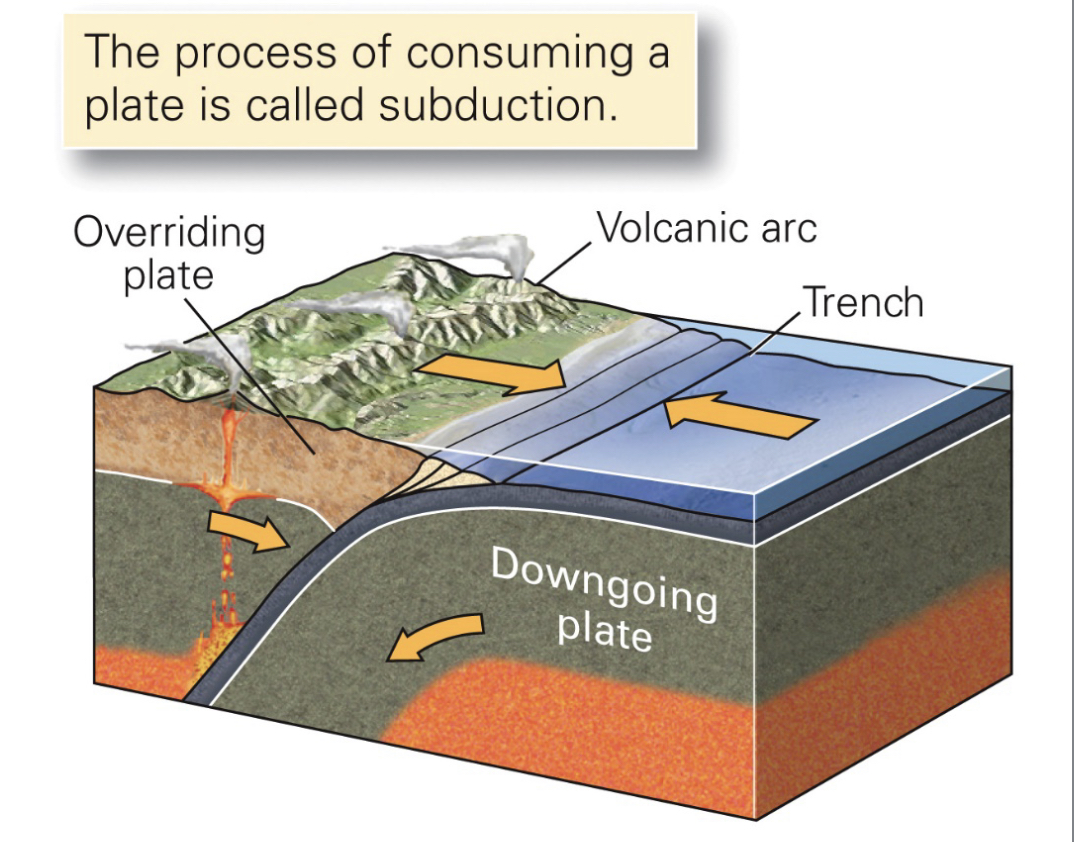
Subduction Zones
Where one plate (lithosphere) bends and sinks down (subducted) into the asthenosphere beneath another plate
Oceanic crust (Mafic) is more dense than continental crust (felsic)
Convergent Plate Boundaries Angles
angles of subduction range from a few degrees to 90 averaging about 45
Depends on the density
Old Lithosphere is cold and dense (steep angle)
Young Lithosphere is warn and buoyant (shallow angle)
Transform Fault Boundaries
Plates slide horizontally past each other without the destruction of the lithosphere
ex: San Andreas Fault
Transform Fault Boundaries Picture
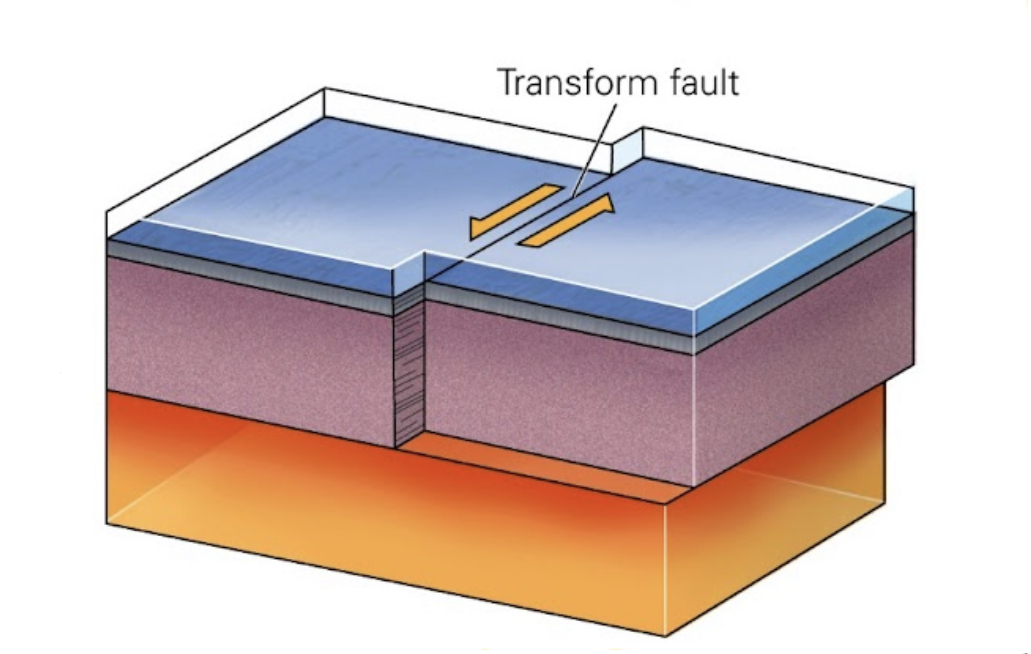
Sea Floor Spreading
True divergent plate boundaries occur along mid-ocean ridges
new ocean crust is formed along the ridge in order to “fill in the space” missing as the two plates move away from each other
As spreading continues, older crust moves farthe
Convergent Plate Boundaries
Includes an Accretionary Prism
material accreted onto the overriding plate at a convergent plate margin
Like a plow scraping off material
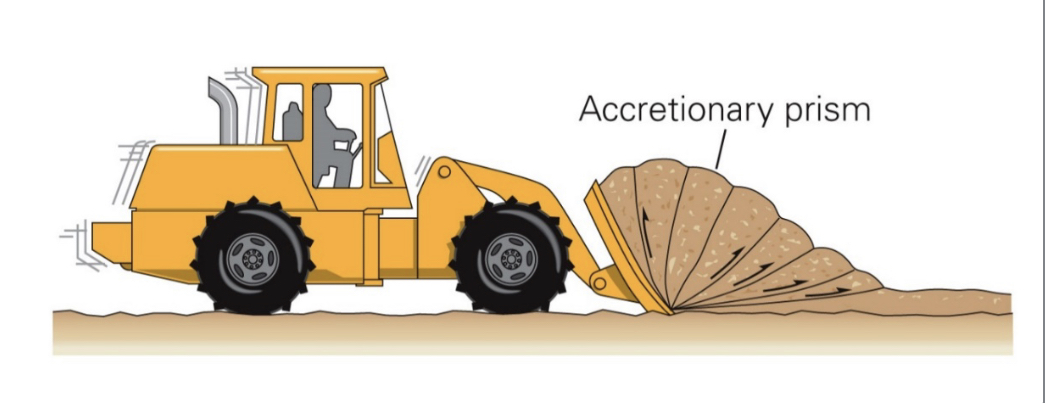
Convergent Plate Boundary
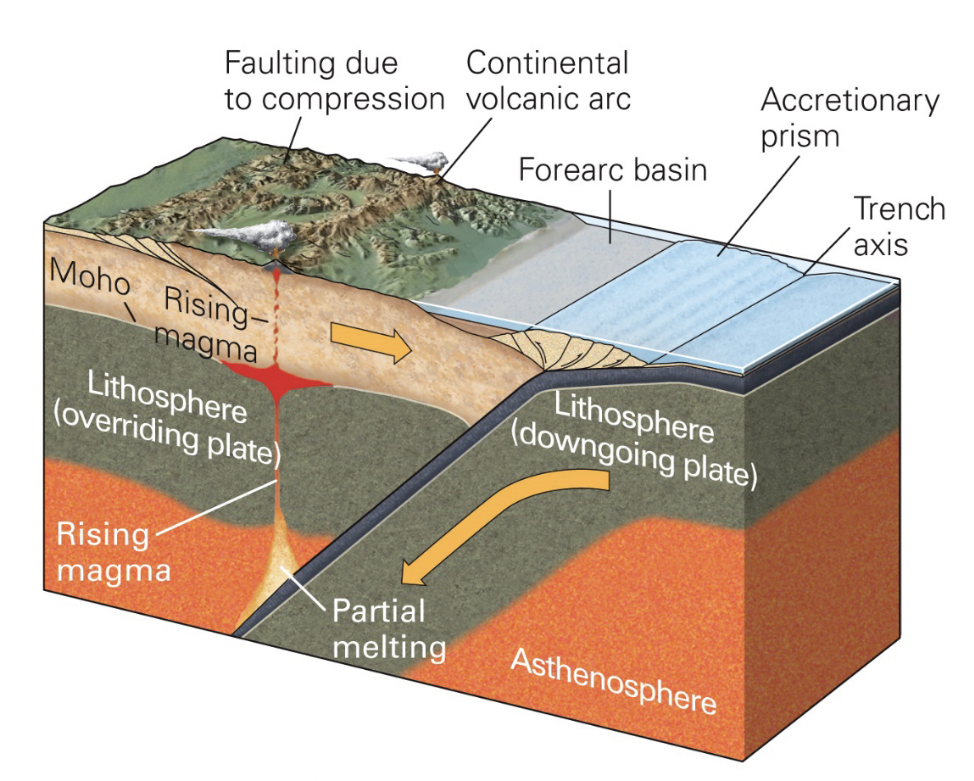
Accretionary Prism
A wedge-shaped mass of sediment and rock scrapped off the top of a down-going plate
like a plow scraping off material
Continental Volcanic Arc
Has Partial Melting - the melting of a rock of the minerals with the lowest melting temperatures, while the other minerals remain solid
Commonly happens at 100-150 km in depth
Water allows the mangle to partially melt, while allows the magma to form
Partial Melting
The melting of a rock of the minerals with the lowest melting temperatures, while the other minerals remain solid
What are the two types of Convergent Zones?
Oceaninc
Oceanic - Oceanic Convergent Zone
Creates volcanic island arcs
Aleutians, Mariana, and Tonga
Located 100-300 km from a deep-ocean trench
Back-Arc Basin-Depression formed behind a volcanic island arc
Oceanic - Oceanic Convergent Zon
Continental - Continental Convergent Zone
Subduction ends when two continental plates collide (collision)
Continental plate desists is so low that they cannot be subjected, so the former trench becomes a suture (a linear belt of high deformed rocks)
A collisional mountain belt forms where the tow plates collided and the down-going plate breaks off (detached)
Suture
A linear belt of highly deformed rocks
Continental - Continental Convergent Zone
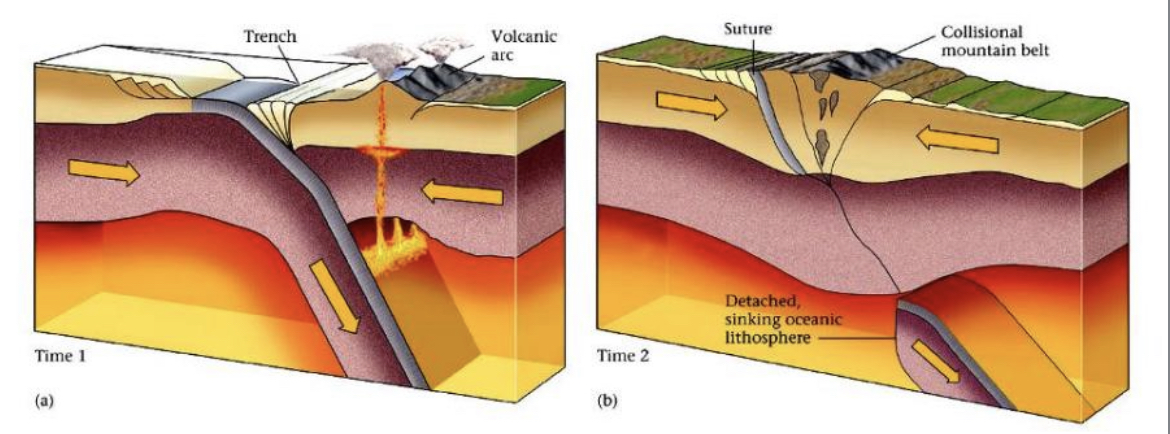
Earthquake
A vibration caused by the sudden breaking or frictional sliding of a rock in the earth
Fault
A g
Epicenter
The point on the surface of the earth directly above the focus of an earthquake
Fault trace
The intersection between a fault and the ground surface
Creep
Movement along faults occurs gradually and relatively slowly and smoothly
Fault displacement without significant earthquake activity
Elastic Rebound
“Springing back” of a rock once an earthquake h
Footwall
The rock mass that lies below the fault plane
Hanging wall
The rock or sediment above an inclined fault plane
Transform/Strike-Slip Faults
Motion can be left lateral or right lateral
Standing on one side of a fault, and the other side moves to the left, then the fault is a left lateral
Reversely, standing on one side of a fault, and the other side moves to the right, then the fault is right lateral
Does not matter which side of the fault you stand on, the motion is the same
Surface Waves (Rayleigh and Love Waves)
Complex motion
Cause greatest destruction eaves exhibit greatest amplitude and slowest velocity
Waves have the greatest periods (time interval between crests)
Surface Waves (Rayleigh Waves)
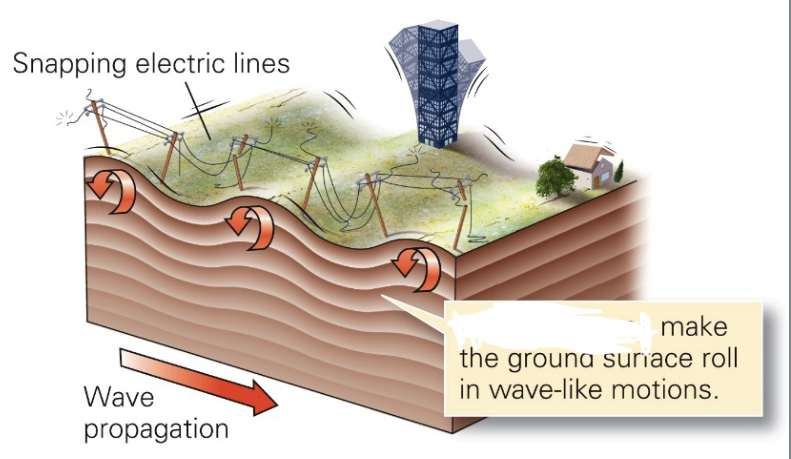
Surface Waves (Love Waves)
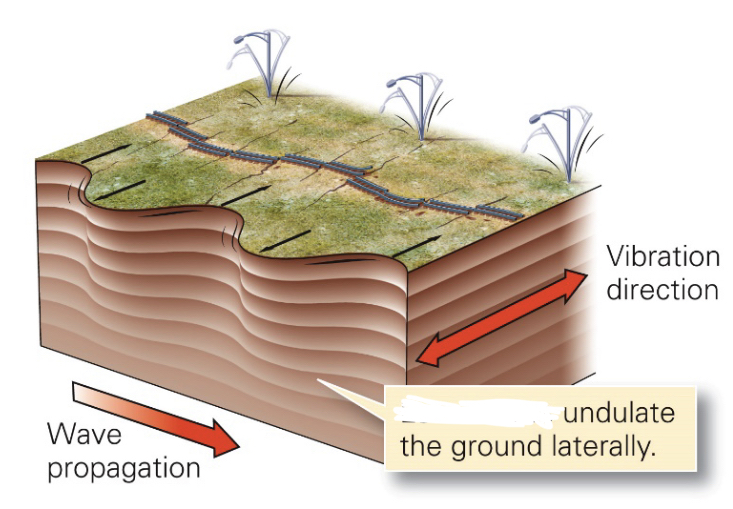
Surface Waves (Body Waves)
Travel deep into the earths interior
Type types:
P-Waves
S-Waves
What are the two types of Seismic Body Waves?
P-Waves
S-Waves
P-Waves
Primary Waves
Compression - push/pull motion
Fastest
Generally, in any solid material, P waves travel about 1.7 times father than S waves
Travels through liquids, solids, and gases
S-Waves
Secondary Waves
Shear
Shaking motion at right angles to their direction of travel
Slower than P-Waves
Travel only through solids
S-Waves
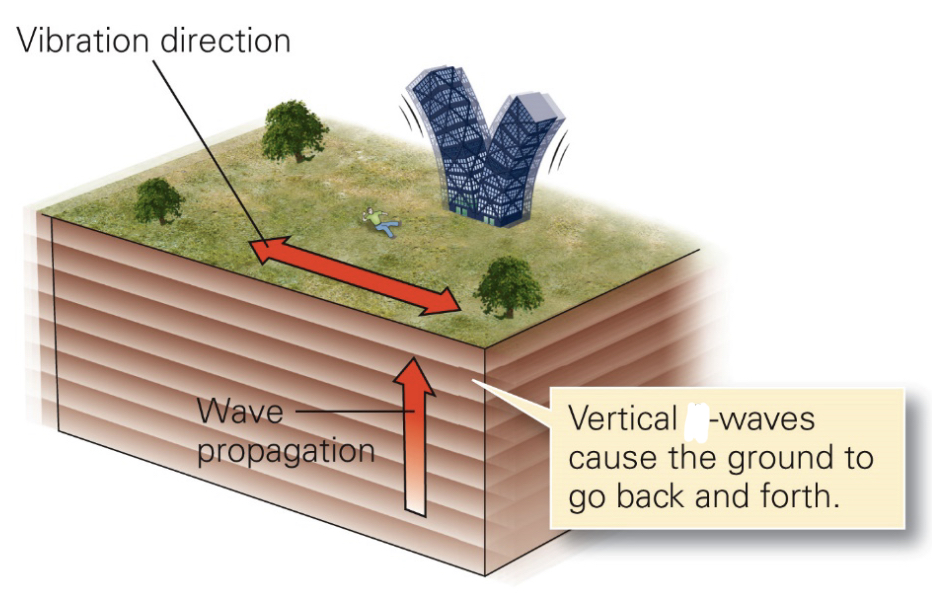
P-Waves
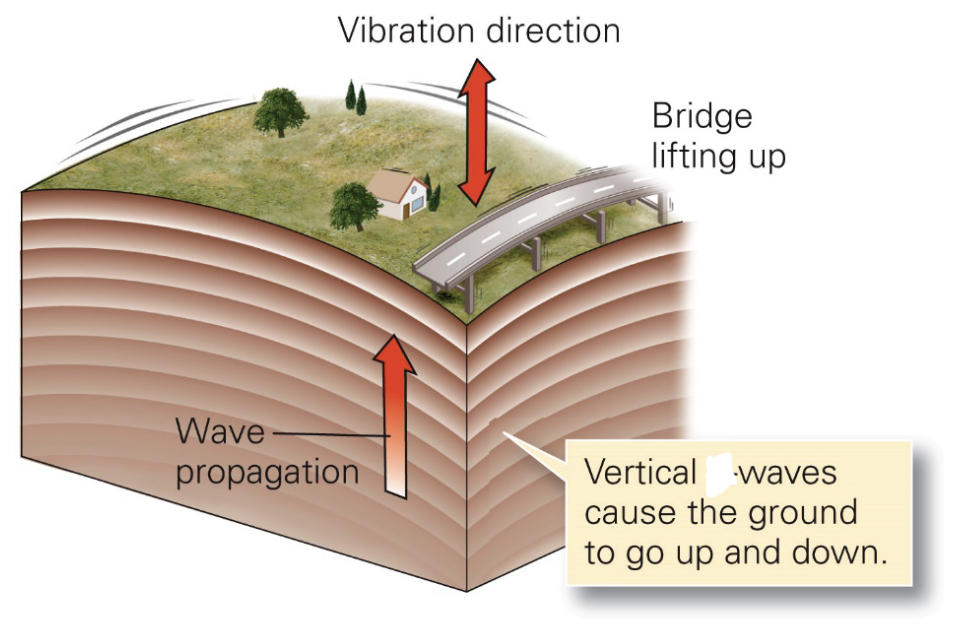
Seismic Waves
Different physical properties of waves produced by earthquakes, cause them to travel at different rates
P-Wave = Fastest
S-Waves = Moderate
Surface Wave = Slowest
Which type of Seismic Wave is fastest?
P-Waves
Which type of Seismic Wave is the Slowest?
Surface Wave
Which type of Seismic Wave is moderate/middle speed?
S-Wave
Seismogram
The data record from a seismograph. It depicts earthquake wave behavior, particularly the arrival time of the different waves
which is used to determine the distance to the epicenter
What is used to record an earthquakes wave data?
Seismograph
Richter Scale
Determined by first calculating the interval between the S- and P- waves
Then determine the amplitude of the largest wave produced
Draw a line on special graph paper between these two points
The earthquakes magnitude is where the line intersects
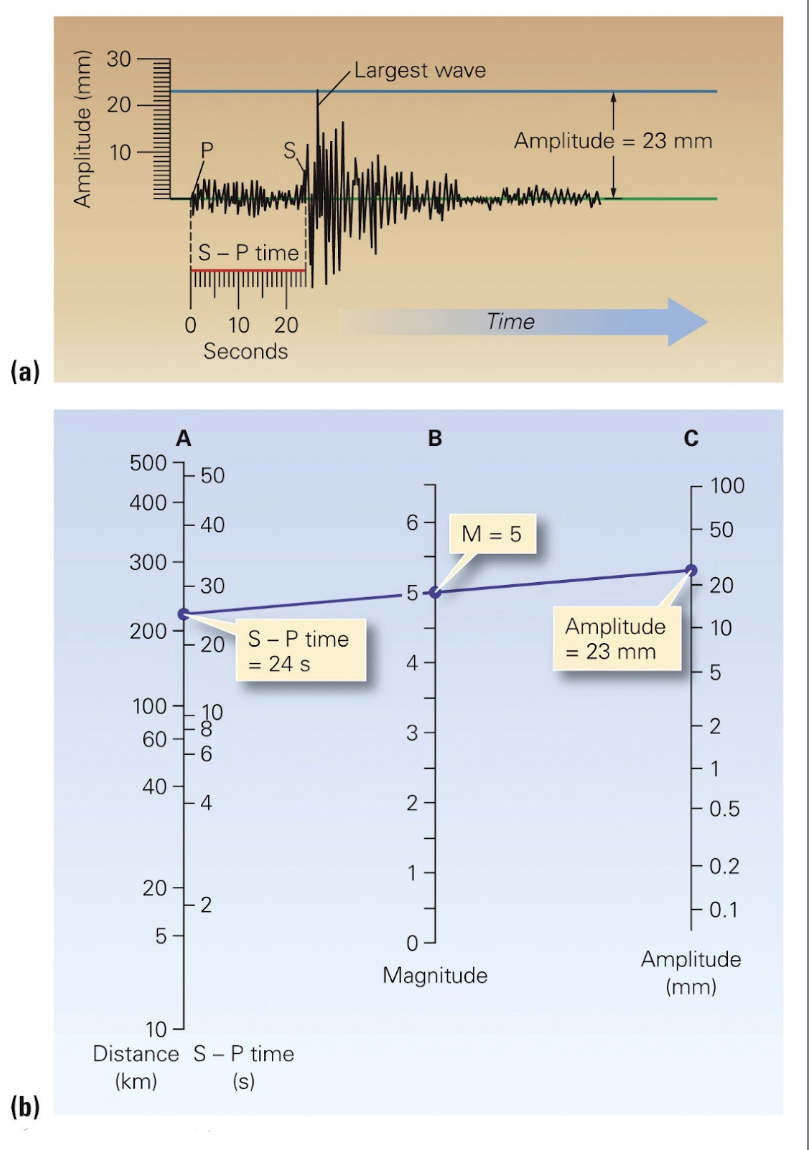
What Factors influence destruction in earthquakes?
local foundation conditions
Building standards/codes
Population density
Structural Damage/Destruction in a Earthquake
the intensity
Durations of vibrations
The nature of material upon which the structure rests
The design
Liquefaction
The process that occurs when the motion of an earthquake causes sand and clay-rich sediment to become a slurry of sand, clay, and water
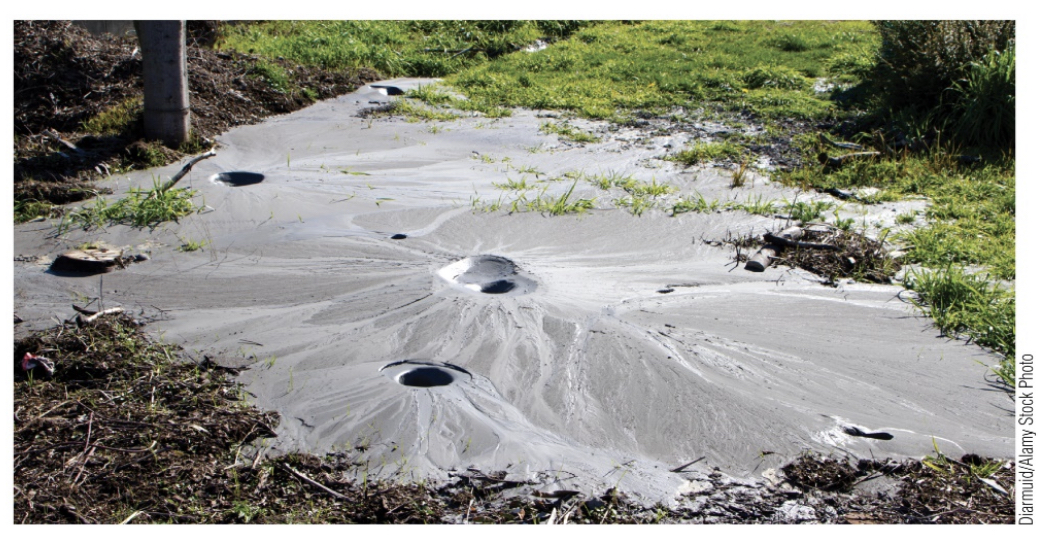
P-Wave shadow zone
Caused by the refraction of P-Waves through the earths core
Occurs because seismic velocities are much lower in the liquid outer core than in the overlying mantle, so the Waves are refracted in a way that leaves a gap
S-Waves shadow zone
Differs from the P-wave zone because the physical properties of S-waves do not let them travel through liquids
therefore, they cannot penetrate the liquid outer core of the earth
The inner core is solid
Volcano
A mountain formed by the accumulation of extrusive volcanic or a vent from which melt from inside the earth spews out onto the planets surface
direct consequence of plate tectonics and mantle convection (convergent and divergent boundaries)
What determines how violently a volcano will erupt?
Temperature
Magmas composition
Dissolved gases
Viscosity
A measure of a materials resistance to flow (e.g., higher viscosity materials flow with greater difficulty)
syrup is more viscous than water
What factors affect viscosity?
Temperature - hotter magmas are less viscous
Composition - Silica content
Gasses
dissolved gasses increase the fluidity of magma
Escaping gases propel the molten rock
Felsic Magmas
Higher silica content, lower Fe and Mg
Higher viscosity (rhyolite)
Mafic Magmas
Lower silica content, higher Fe and Mg
Lower viscosity (basalt)
How do gases affect viscosity?
dissolved gases increase the fluidity of magma
Escaping gases propel the molten rock
Volatiles move upward when an eruption is about to happen
Gases of most magmas makeup 1-6 percent of the total weight (most water Vapor)
Help to create a narrow conduit that connects the magma chamber to the surface

Mafic (Basaltic) Magma
least silica content (~50%)
Least viscosity
Least gas content (1-2%)
(Andesitic) Magma I
intermediate silica content (~60%)
Intermediate viscosity
Intermediate gas content (3-4%)
Felsic (Rhyolitic) Magma
Most silica content (~70%)
Greatest viscosity
Most gas content (4-6%)
What are the types of Basaltic Lava Flows?
Pahoehoe
Aa
Pahoehoe Basaltic Lava Flow
congealing of basaltic lavas that form relatively smooth skin that wrinkles as the molten subsurface lava continues to advance
Lava Tubes - tunnel in hardened lava that acts as a horizontal conduit for lava flowing from a volcanic vent
Pahoehoe Basaltic Lava Flow
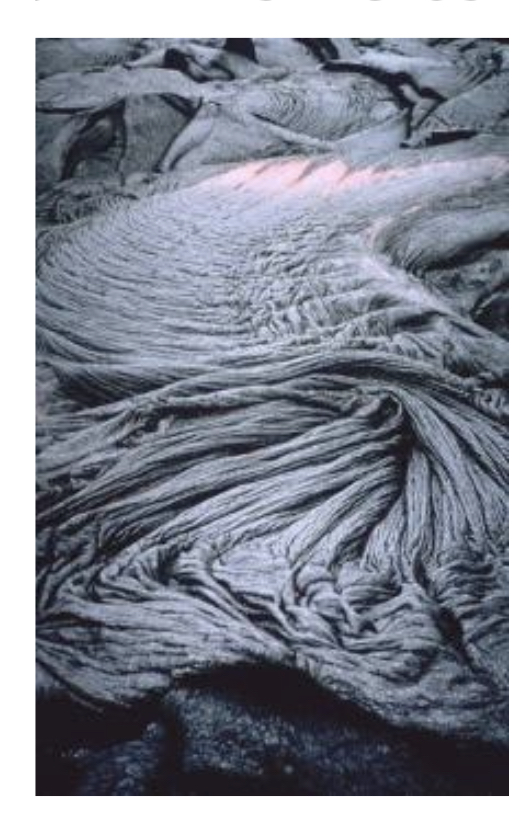
Aa Basaltic Lava Flow
a basaltic lava that has a surface of rough jagged blocks with sharp edges
Move much slower than a Pahoehoe flow
Aa Basaltic Lava Flow

What are the types of Effusive Eruptions?
Shield Volvanoes
Flood Basalts
What are the types of Explosive Eruptions?
Stratovolcanoes
Lava Domes
Cinder Cones
Shield Volcanoes
Gentle outpouring of low-silica fluid lavas from a central vent or conduit
like a shield laid on the ground
Formed by hotspots
Fissure-crack along the flanks of a shield volcano that erupt lava
Ex: Iceland, Hawaiian Islands
Shield Volcanoes
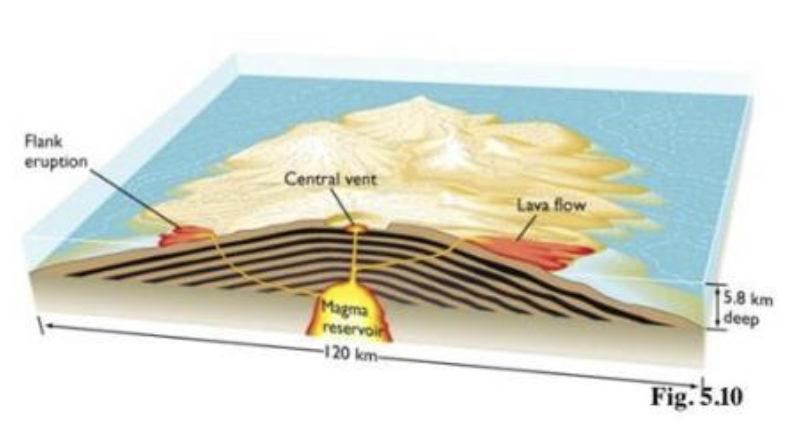
Strati / Composite Volcanoes
Combination of effusive and explosive volcanic activity
Pyroclastic material and lava in alternating layers
Occur landward side of a subduction zone
Ex: Mount Fuji, Mount Vesuvius
Lahars
Fast moving volcanic debris flow
mobilization of debris by water (precipitation, melting snow, a lake, etc.)
Ex: Colombias Nevada del Ruiz (17,800 feet high)
Reached 30 miles away in minutes
130 foot high Lamar entombed 20,000 people in mud
Pyroclastic Debris
Turbulent mixtures of hot gases and Pyroclastic material that travel with great velocity
includes Tephra, ash, bombs, blocks
Various sizes
Tephra
Volcanic rock ejected during an eruption
ash, bombs, blocks
Pyroclastic Flow - Nuer Ardente (Growing Cloud)
Associated with composite cone volcanoes
Nuer Ardente- Pyroclastic flow that consist of hot gases infused with incandescent ash and larger rock fragments
Full of gases and hot, buoyant air
60 miles from the source
Nuer Ardente
Pyroclastic flow that consists of hot gases infused with incandescent ash and larger rock fragments
full of gases and hot, buoyant air
Cinder Cones
Built from ejected lava fragments that take on the appearance of cinders
smallest and most numerous
Usually erupt once
Built of Pyroclastic material (tephra)
Blocks
Bombs
Lapilli
Ash dust
Calderas
Giant volcanic depression usually formed after a large eruption
the magma chamber below empties and the volcano collapses into the emptied chamber
Much larger than a crater
Ex: crater lake, oregon
Calderas
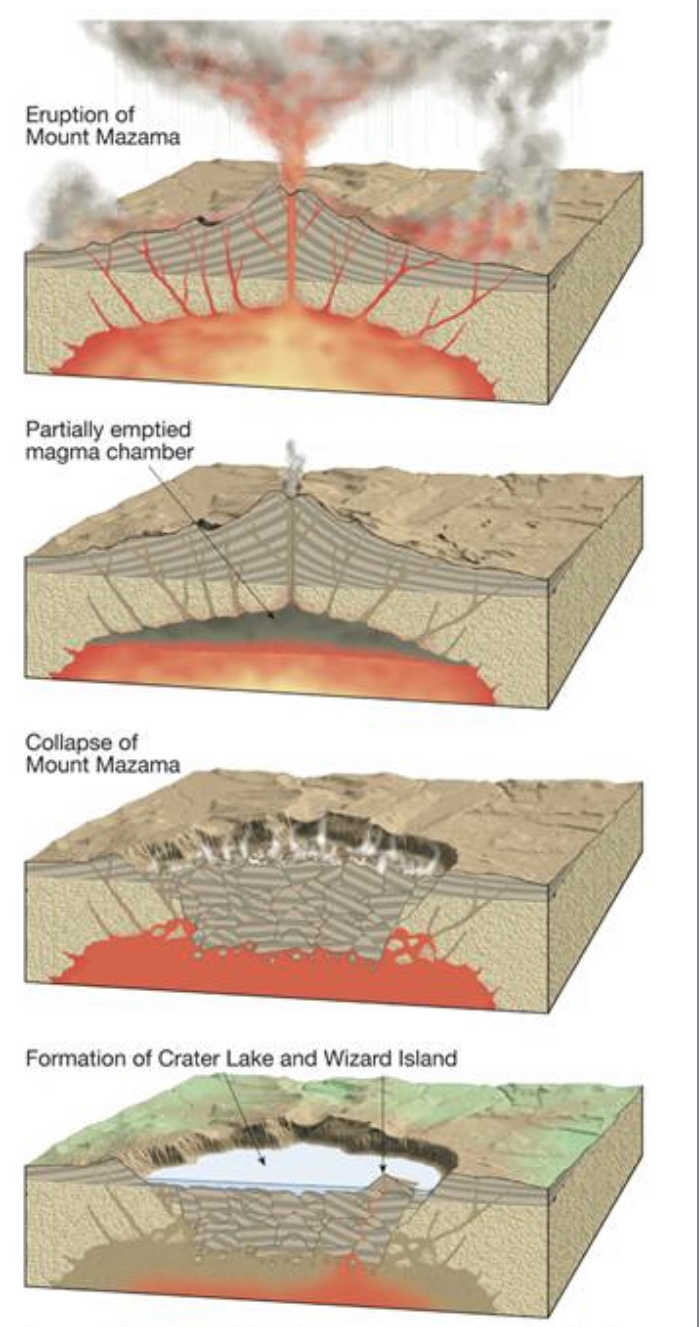
Dikes
Magma injected into fracture perpendicular to bedding plane
Sills
Magma injected into fractures along a bedding plane
Laccoliths
Similar to a sill but magma more viscous
Batholith
Largest igneous body